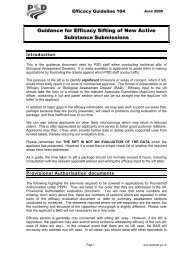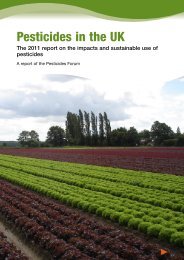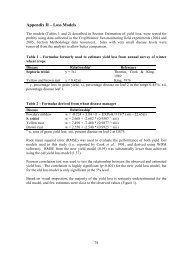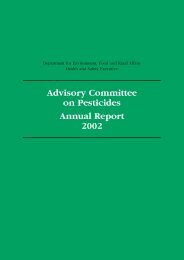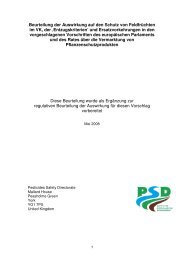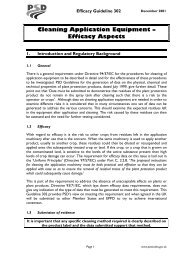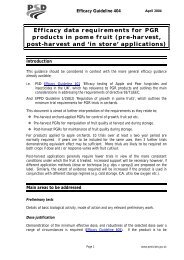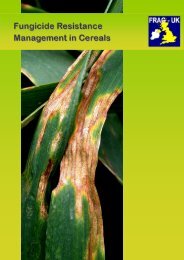Advisory Committee on Pesticides Annual Report 2001
ACP Annual Report 2001 - Pesticides Safety Directorate
ACP Annual Report 2001 - Pesticides Safety Directorate
Create successful ePaper yourself
Turn your PDF publications into a flip-book with our unique Google optimized e-Paper software.
<str<strong>on</strong>g>Advisory</str<strong>on</strong>g> <str<strong>on</strong>g>Committee</str<strong>on</strong>g> <strong>on</strong> <strong>Pesticides</strong> <strong>Annual</strong> <strong>Report</strong> <strong>2001</strong><br />
c) approval for the professi<strong>on</strong>al use of slow-release strips and c<strong>on</strong>trollable and<br />
n<strong>on</strong>-c<strong>on</strong>trollable cassettes c<strong>on</strong>taining dichlorvos in museums be retained<br />
subject to the fulfilment of physicochemical, operator exposure and efficacy<br />
data requirements;<br />
d) approval for the use of slow-release strips in pherom<strong>on</strong>e traps in areas<br />
where food may be stored, prepared or c<strong>on</strong>sumed be suspended pending<br />
the provisi<strong>on</strong> of informati<strong>on</strong> <strong>on</strong> food residues; and<br />
e) approval for the use of slow release strips in pherom<strong>on</strong>e traps in areas<br />
where food is not present be retained subject to the fulfilment of<br />
physicochemical and efficacy data requirements.<br />
A review of the agricultural uses of dichlorvos was also c<strong>on</strong>sidered by the<br />
ACP at the same time (see page 42).<br />
58<br />
The ACP also noted that dichlorvos was under discussi<strong>on</strong> by the <str<strong>on</strong>g>Committee</str<strong>on</strong>g><br />
<strong>on</strong> Mutagenicity of Chemicals in Food, C<strong>on</strong>sumer Products and the<br />
Envir<strong>on</strong>ment (CoM), and recognised that their recommendati<strong>on</strong>s would<br />
perhaps require modificati<strong>on</strong> in accordance with the COM’s findings.<br />
At the July <strong>2001</strong> ACP meeting, the <str<strong>on</strong>g>Committee</str<strong>on</strong>g> c<strong>on</strong>sidered the implicati<strong>on</strong>s of<br />
the COM’s possible c<strong>on</strong>clusi<strong>on</strong>s, and agreed to advise Ministers as follows:<br />
a) If the COM’s final c<strong>on</strong>clusi<strong>on</strong>s were that dichlorvos was an in-vivo<br />
mutagen, and it could not exclude the possibility that the occurrence<br />
of tumours in animal tests of carcinogenicity resulted from a genotoxic<br />
mechanism, there should be immediate revocati<strong>on</strong> of all uses (both<br />
agricultural and n<strong>on</strong>-agricultural).<br />
b) Alternatively, if the COM c<strong>on</strong>cluded that dichlorvos was an in-vivo<br />
mutagen, but that the tumours observed in animal tests did not result from<br />
a genotoxic mechanism, or if it could not c<strong>on</strong>firm that dichlorvos was an<br />
in-vivo mutagen, or if it took the view that dichlorvos was not an in-vivo<br />
mutagen, then the ACP’s previous recommendati<strong>on</strong>s would be maintained.<br />
The COM c<strong>on</strong>cluded, following a sec<strong>on</strong>d meeting in July <strong>2001</strong>, that dichlorvos<br />
should be regarded as an in-vivo mutagen (i.e. capable of inducing mutati<strong>on</strong>s<br />
in living animals) at site of c<strong>on</strong>tact and that it could not exclude the possibility<br />
of it acting as a genotoxic carcinogen. The COM statement <strong>on</strong> dichlorvos was<br />
finalised in late July <strong>2001</strong>.<br />
C<strong>on</strong>sequently the ACP recommended to Ministers that, as a precauti<strong>on</strong>ary<br />
measure, it would be prudent to revoke, with immediate effect, all agricultural




